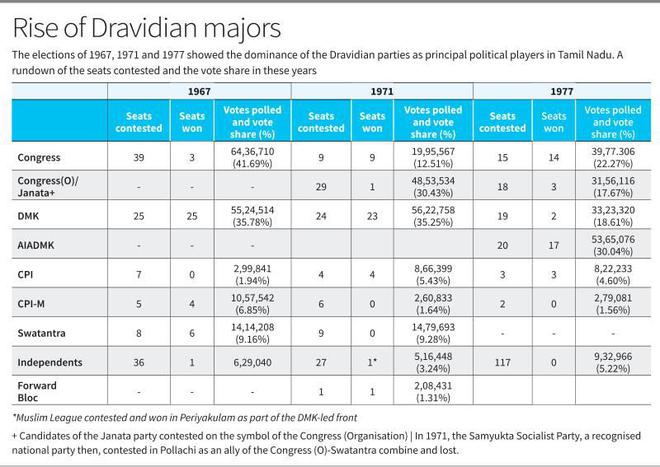The decade starting from 1967 marked a pivotal moment for Tamil Nadu, as it witnessed the rise of two significant Dravidian parties: the Dravida Munnetra Kazhagam (DMK) and the All India Anna Dravida Munnetra Kazhagam (AIADMK).
Since 1977, these two parties have remained the dominant forces in the State’s political landscape, solidifying their positions as the primary players in Tamil Nadu’s political arena.
In the 1967 Lok Sabha election held in the State along with the Assembly poll, the DMK-led United Front (UF), consisting of Swatantra, Communist Party of India (Marxist) and the Muslim League, took on the then ruling Congress. Interestingly, the DMK founder C.N. Annadurai, who tasted defeat in Kancheepuram in the 1962 Assembly election, preferred to contest from the South Madras Lok Sabha constituency five years later, despite being the head of the DMK and the front. Even though he won, he quit the MP post to become the first non-Congress Chief Minister of the State, post-Independence.

In the Lok Sabha election, the UF bagged 35 seats, of which the DMK secured 25, Swatantra - six and the CPI(M) - four. The Congress could get only three - Nagapattinam, Tenkasi and Nagercoil (now called Kanniyakumari) - with most of its prominent faces, C. Subramaniam and R. Venkataraman (Thanjavur) biting the dust.
Even though the Congress, at the all India level, scraped through in 1967 and formed a government with a slender majority, it experienced a huge split two years later. The party had witnessed a vertical split - the Congress (Requisitionists or Ruling) and the Congress (Organisation). Former Chief Minister K. Kamaraj, who was one of those responsible for Indira Gandhi to become Prime Minister in 1966 and 1967, found himself with critics of Indira Gandhi. With this development, the alignments changed in the State too. The DMK became a friend of the Congress (R ). Meanwhile, in the early 1969, M. Karunanidhi became Chief Minister with the death of Annadurai. In March 1971, the country faced snap polls.
While the DMK won in 23 constituencies in the State, its major partner, Congress (R), captured nine and another partner, the CPI secured four. The Forward Bloc and the Muslim League netted one each. An interesting feature was the narrow margin of difference in the erstwhile Tiruchendur Lok Sabha constituncy with which M. S. Sivasamy of the DMK was declared elected, defeating M. Mathias of the Swatantra by 26 votes.
The election also saw two long-standing rivals in Tamil Nadu politics - Kamaraj and C. Rajagopalachari or Rajaji - coming together. Their parties, Congress (O) and Swatantra, faced the election along with the Samyukta Socialist Party (SSP). Kamaraj was the solitary winner of the Opposition and he was elected from Nagercoil.
The following years saw many events in the State including the dramatic split in the DMK. In October 1972, the DMK’s treasurer and seasoned film actor, M.G. Ramachandran, broke away from the party to establish the AIADMK. Both Rajaji (1972) and Kamaraj (1975) passed away, leaving the political field a direct battleground between Karunanidhi and MGR. Even when Kamaraj was alive, the AIADMK had registered its electoral success in the Dindigul Lok Sabha by-poll in May 1973. The Emergency years witnessed the DMK turning a bitter critic of the Congress. In January 1976, Karunanidhi-headed DMK Ministry was dismissed and the State Assembly dissolved. Next month, a faction in the Congress (O), led by G.K. Moopanar, merged itself with the Congress, led by Indira Gandhi.
Naturally, the AIADMK and the Congress became allies in the 1977 Lok Sabha election. The Janata Party, an amalgam of many Opposition parties including the Congress (O), Bharatiya Lok Dal, Jan Sangh and the Socialists, came into being for all practical purposes, ahead of the poll but its nominees were fielded on the symbol of the Congress (O) in Tamil Nadu. The AIADMK-Congress combine, along with the CPI, swept the State with 35 seats. Both C. Subramaniam and R. Venkataraman emerged victorious this time from Pollachi and South Madras. The remaining four seats were shared by the Congress (O) with three and its ally, DMK, one. The CPI (M), which had aligned itself with the Congress (O) and the DMK, drew a blank.







